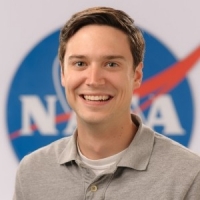Feb 23 2016
Every January, the American Institute of Aeronautics and Astronautics (AIAA) hosts the SciTech Conference which showcases next-generation innovations in aerospace technologies. This year, CEAS Department of Aerospace Engineering and Engineering Mechanics (AEEM) PhD students Brandon Cook, Nicholas Hanlon, Sarthak Kukreti and Anoop Sathyan presented their research papers on state-of-the-art advancements in unmanned aerial vehicle (UAV) technology.
 Brandon Cook
Brandon Cook
This was Brandon Cook’s third year attending the AIAA SciTech Conference. Cook presented his research paper “A Fuzzy Logic Approach for Low Altitude UAS Traffic Management (UTM),” which was co-authored with AEEM professor, Kelly Cohen, PhD.
“While many of industry leaders, such as Amazon’s package delivery services, want to be able to fly their UAV’s at this very moment, there are several standards, regulations, and technologies that need to be in place prior to allowing beyond-line-of-sight operation in populated areas—for example, flying your aircraft autonomously or remotely over a city,” explains Cook. As the number of drones in the air surges year after year, it is imperative that aerospace engineers are integrating technology into the design process that reduces that amount of potential mid-air collisions.
Cook’s research on fuzzy logic is doing just that, he explains, “By utilizing the bio-inspired fuzzy-logic approach which resembles human-like decision making responses, the drones essentially have the ability to “think” for themselves and adapt to the situation at hand. Therefore, my work focuses on helping develop a platform to enable this beyond-line-of-sight operation.”
Anoop Sathyan, a second-time presenter at AIAA SciTech, spoke about his research on “Deep Convolutional Neural Network for Human Detection and Tracking in FLIR Videos,” at this year’s SciTech conference. His paper was co-authored with CEAS Department of Mechanical and Materials Engineering professor Manish Kumar, PhD. This research focuses on the methods of detecting and tracking humans in wild-fire situations by utilizing fire detection algorithms, human detection and tracking technology, localization techniques and infrared video cameras.
As a part of the CEAS Surveillance for Intelligent Emergency Response Robotic Aircraft (SIERRA) project, Sathyan’s research will significantly contribute to the group’s mission to save more firefighters’ lives who fight wildfires. The CEAS SIERRA project equips firefighters with unmanned aerial vehicles (UAV) which have global positioning systems, environmental data, video and fire-prediction software to give real-time information about where a fire is burning, and where it is moving.
The 2016 AIAA SciTech conference allotted Cook and Sathyan the opportunity to network with up-and-coming and established aerospace researchers. Cook reflects, “While presenting your work at such a large conference gives you the valuable experience of preparing and delivering a technical presentation, you also gain the opportunity to see some of the newest and ground-breaking developments in the aerospace industry.”
Source: http://www.uc.edu/